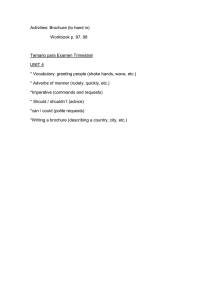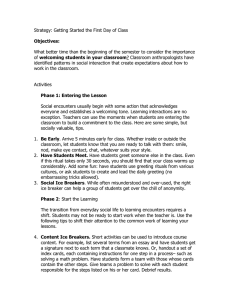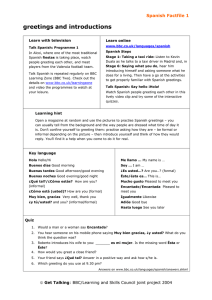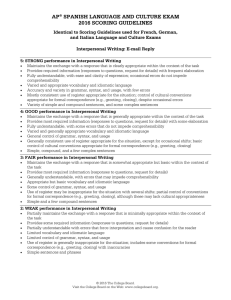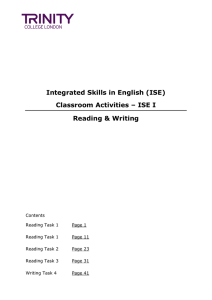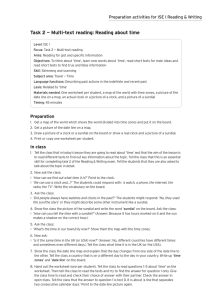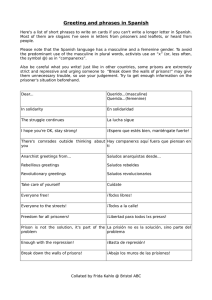Task 2 – Multi-text Reading: Greeting Cards At a glance Procedure
Anuncio
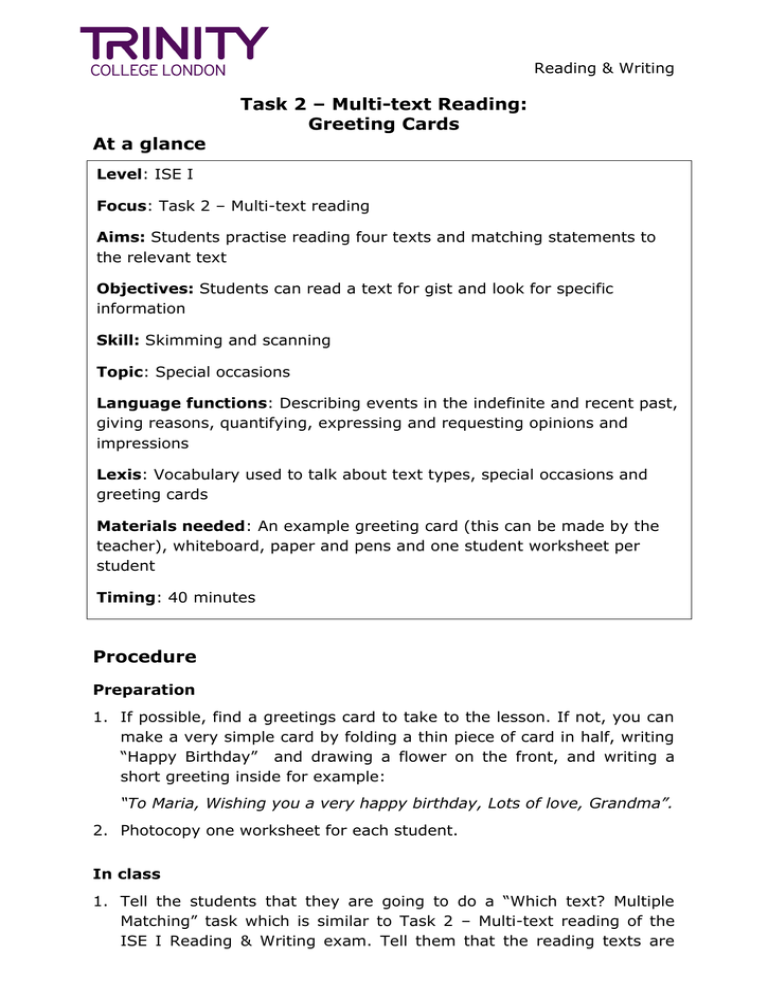
Reading & Writing Task 2 – Multi-text Reading: Greeting Cards At a glance Level: ISE I Focus: Task 2 – Multi-text reading Aims: Students practise reading four texts and matching statements to the relevant text Objectives: Students can read a text for gist and look for specific information Skill: Skimming and scanning Topic: Special occasions Language functions: Describing events in the indefinite and recent past, giving reasons, quantifying, expressing and requesting opinions and impressions Lexis: Vocabulary used to talk about text types, special occasions and greeting cards Materials needed: An example greeting card (this can be made by the teacher), whiteboard, paper and pens and one student worksheet per student Timing: 40 minutes Procedure Preparation 1. If possible, find a greetings card to take to the lesson. If not, you can make a very simple card by folding a thin piece of card in half, writing “Happy Birthday” and drawing a flower on the front, and writing a short greeting inside for example: “To Maria, Wishing you a very happy birthday, Lots of love, Grandma”. 2. Photocopy one worksheet for each student. In class 1. Tell the students that they are going to do a “Which text? Multiple Matching” task which is similar to Task 2 – Multi-text reading of the ISE I Reading & Writing exam. Tell them that the reading texts are Reading & Writing about greeting cards. Hold your example greetings card up in front of the class. Ask students if they know what it is. If not, explain that it is something that people in the UK and the USA like to send to their friends and family on special occasions. 2. Write “Special occasions” on the board. Elicit one special occasion from the class. Put students into small groups, and tell them they have one minute to list all of the special occasions they can think of. Stop them after one minute, elicit all of their answers, and write them on the board. Add the following if they are not already on the list: Birthdays, Christmas, graduation, new home, engagement 3. Tell students they are going to read four different texts about greetings cards. Give each student one worksheet. Put the students in pairs and ask them to discuss what kind of text they think text A, B, C or D is and where they would expect to find it. After two minutes, discuss as a class. Example answers: Text A - A description of the tradition of sending greeting cards. It could be found in a school textbook. Text B - Infographics on greetings cards. It could be found in a magazine. Text C - An explanation of how e-cards work. It could be found on the homepage of a website selling e-cards. Text D - An example greetings card verse. It could be found inside a Mother’s Day card. 4. Now ask the students to complete the Which text? Multiple Matching questions on the worksheet. Give students 10 minutes to answer the questions individually. Then ask the students to compare their answers in pairs. 5. Go through the answers with the class. Explain any vocabulary the students do not understand. 6. Draw the students’ attention to Task B on the worksheet. Ask students to discuss in pairs. Monitor and provide help where necessary. After 10 minutes, briefly elicit some answers from the class. Reading & Writing Extension activity 1. Early finishers during the reading activity can write their own Which text? questions. 2. Early finishers during the speaking activity can talk about other special occasions. Further support activity Weaker students can be given a choice of two texts for each Which text? question. After class For homework, students can be asked to write an email to a friend describing the tradition of sending greeting cards. Reading & Writing Student Worksheet Task 2 – Multi-text Reading: Greeting Cards Aim: To practise Which text? Multiple Matching (Part 2 of the ISE I Reading & Writing exam) Read the following texts about greetings cards, then answer the questions below. Text A Over 2 billion greeting cards are sold in the UK each year. People in the UK send more cards per capita than any other nation. The greetings cards industry is also big in the US, but the custom is not consistently observed anywhere else. Cards are sent to celebrate many types of occasion such as birthdays, Christmas, graduation, new home, engagement, and even divorce. Greeting cards come in different shapes, sizes and styles, including humorous cards, photo cards, artistic cards, and handmade cards. Even in the age of social media, greeting cards continue to play a significant role in UK culture. People still want to celebrate special occasions with their loved ones and to mark many of life’s important moments by sending a card. Reading & Writing Text B Greeting Cards - Facts and figures £1372 million Total market value £1.42 Average retail price of a card £42.5 million Amount spent on Valentine’s Day cards 3% Rise in sales in 2012 compared to 1993 Reading & Writing Text C Welcome to ecards 4 u! We have 100s of greeting cards that can be easily personalised by changing the text or uploading a photo. You’ll find a wide variety of cards, including Birthday Cards, Christmas Cards, Congratulations Cards, Good Luck Cards, Thank You Cards, and Sympathy Cards. Ecards 4 u is the perfect place to create and send thoughtful, funny and custom-made cards. You can also set reminders for special occasions. Ecards cost £1.50 to send by email and £3.50 to send by post. Cards are sent by email within 3 hours, and by post the next working day. Text D My darling mum, you’re everything to me. Thanks to you I am happy and free. You've made me who I am today, by supporting me in every way. Together we have laughed and cried, you’ve always been there by my side. I’ll be there for you until the end because you’re my mum and my best friend. Reading & Writing Questions A. Read questions 1-5 first and then read the four texts again. As you read each text, decide which text each question refers to. You can use any letter more than once. Which text… a) advertises cards that can be sent electronically? b) tells you how many cards are bought annually in the UK? c) shows the kind of text that can be found inside a greeting card? d) gives the price of personalised greeting cards? e) compares the sales of greeting cards in two different years? B. Discussion Questions Discuss the following questions in pairs. a) Have you ever sent or received a greeting card? Who was it to/from? For what occasion? b) Did anything that you learnt about greeting cards today surprise you? What?/Why? c) Do you think that divorce cards are a good idea? Why?/Why not? d) What is your favourite special occasion and how do you usually celebrate it? Reading & Writing Answer Key A. a) b) c) d) e) C A D C B Original sources: http://www.greetingscards.co.uk/helpdesk/additional-information/thehistory-of-greetings-cards http://www.greetingcardassociation.org.uk/resources/for-publishers/themarket/facts-and-figures http://www.bbc.co.uk/news/magazine-18020006 http://www.moonpig.com/uk/ http://www.craftsuprint.com/card-verses/
